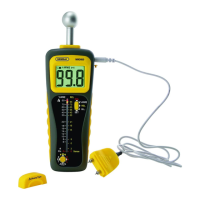3
INTRODUCTION
Thank you for purchasing General Tools & Instruments’ MMD950 Pin/Pinless
Deep Sensing Moisture Meter with Spherical Sensor and Remote Probe. Please
read this user’s manual carefully and thoroughly before using the meter.
The MMD950 is designed for use in woodworking, water damage restoration,
building construction and home renovation. Examples include:
• Checking for moisture on or below the surface of carpets and sub-
flooring
• Measuring the moisture content of wood or drywall before painting,
wallpapering, sealing or treating
• Locating water leaks above ceilings, below floors or behind walls
• Selecting dry lumber
WHICH SENSOR SHOULD YOU USE?
The MMD950 is equipped with a pin-type sensor and a pinless spherical
sensor. The spherical sensor is the only choice for estimating the surface or
internal moisture level of materials like finished wood, paint or wallpaper that
cannot be marred by pinholes. If accurate readings are important, the remote
pin-type probe is the only option because the spherical sensor can only provide
relative readings.
The distinction between absolute and relative readings is important to
understand. The moisture level measurements made by the remote probe’s
test pins are displayed in units of %WME (Wood Moisture Equivalent)
simultaneously on a 6.0 to 87.6 count digital LCD and a 40-LED analog bar
graph. These pin measurements are accurate within 3%.
By contrast, readings made by the spherical sensor are simultaneously
displayed with no units on the LCD and on a second scale (called REL) of the
bar graph. Although the readings from the spherical sensor have no accuracy
specification, they are nonetheless useful for quickly comparing the moisture
levels of materials, or the wetness of different areas of the same material. Two
possible uses for the relative readings are:
1. Determining whether two pieces of wood to be joined have roughly the
same moisture content (which means they will dry out at the same rate
without warping).

